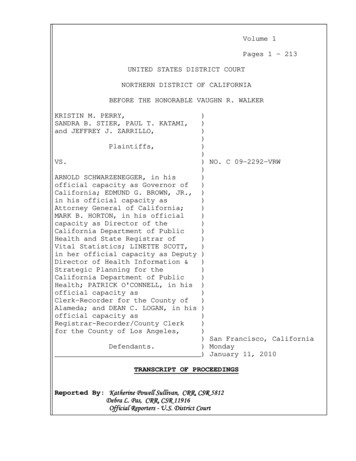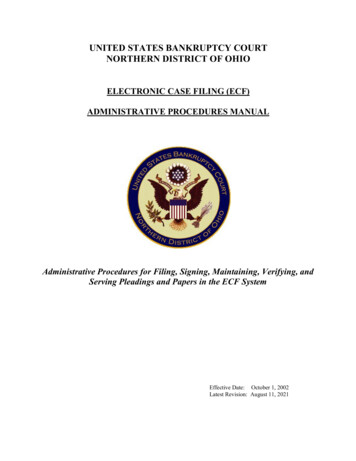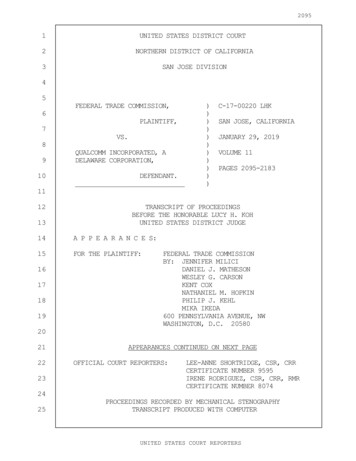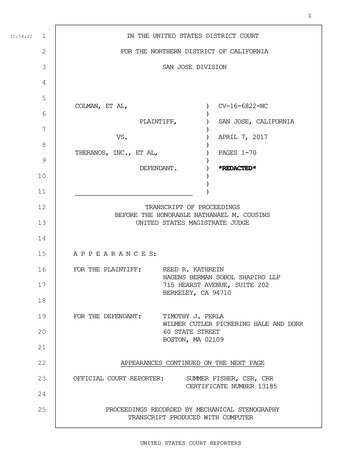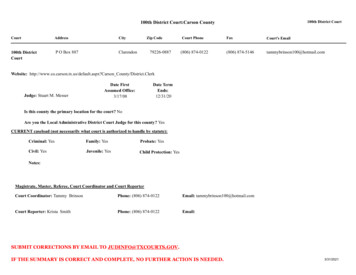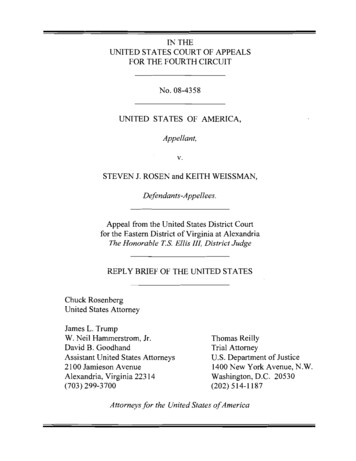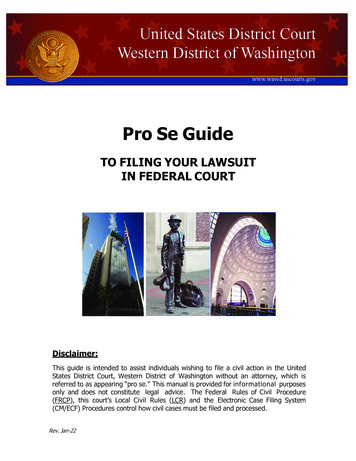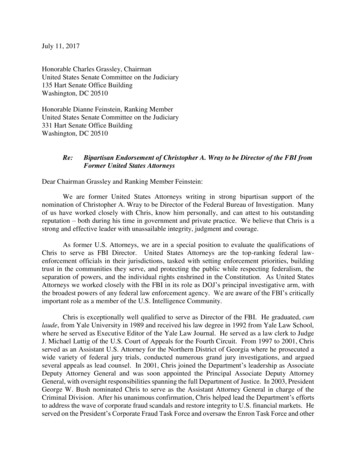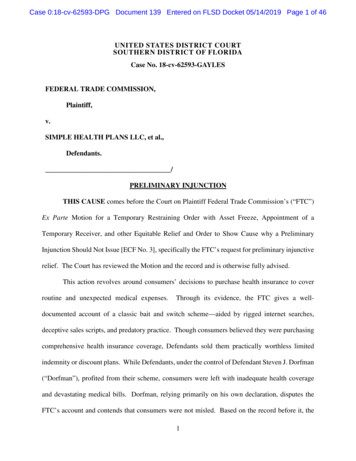
Transcription
Case 0:18-cv-62593-DPG Document 139 Entered on FLSD Docket 05/14/2019 Page 1 of 46UNITED STATES DISTRICT COURTSOUTHERN DISTRICT OF FLORIDACase No. 18-cv-62593-GAYLESFEDERAL TRADE COMMISSION,Plaintiff,v.SIMPLE HEALTH PLANS LLC, et al.,Defendants./PRELIMINARY INJUNCTIONTHIS CAUSE comes before the Court on Plaintiff Federal Trade Commission’s (“FTC”)Ex Parte Motion for a Temporary Restraining Order with Asset Freeze, Appointment of aTemporary Receiver, and other Equitable Relief and Order to Show Cause why a PreliminaryInjunction Should Not Issue [ECF No. 3], specifically the FTC’s request for preliminary injunctiverelief. The Court has reviewed the Motion and the record and is otherwise fully advised.This action revolves around consumers’ decisions to purchase health insurance to coverroutine and unexpected medical expenses.Through its evidence, the FTC gives a well-documented account of a classic bait and switch scheme—aided by rigged internet searches,deceptive sales scripts, and predatory practice. Though consumers believed they were purchasingcomprehensive health insurance coverage, Defendants sold them practically worthless limitedindemnity or discount plans. While Defendants, under the control of Defendant Steven J. Dorfman(“Dorfman”), profited from their scheme, consumers were left with inadequate health coverageand devastating medical bills. Dorfman, relying primarily on his own declaration, disputes theFTC’s account and contends that consumers were not misled. Based on the record before it, the1
Case 0:18-cv-62593-DPG Document 139 Entered on FLSD Docket 05/14/2019 Page 2 of 46Court finds that a preliminary injunction is necessary to protect consumers, prevent futureviolations of the law, protect assets, and to preserve the status quo pending the resolution of thislitigation.PROCEDURAL BACKGROUNDOn October 29, 2018, the FTC filed its Complaint for Permanent Injunction and OtherEquitable Relief [ECF No. 1] against Defendants Simple Health Plans LLC (“Simple Health”),Health Benefits One LLC (“HBO”), Health Center Management LLC (“HCM”), InnovativeCustomer Care (“ICC”), Simple Insurance Leads LLC (“SIL”), Senior Benefits One LLC (“SBO”)(collectively the “Corporate Defendants”), and Dorfman (together with the Corporate Defendantscollectively referred to as the “Defendants”) alleging that Defendants violated Section 5(a) of theFTC Act, 15 U.S.C. § 45(a), and the FTC’s Telemarketing Sales Rule (“TSR”), 16 C.F.R. Part310.In conjunction with the Complaint, the FTC filed an Emergency Ex Parte Motion for aTemporary Restraining Order [ECF No. 3]. On October 31, 2018, the Court entered a TemporaryRestraining Order (the “TRO”) and froze all of Defendants’ assets, including Dorfman’s personalassets. [ECF No. 15]. The Court also appointed Receiver Michael Goldberg (the “Receiver”) toadminister the affairs of the Corporate Defendants and to take necessary actions to protectconsumers. [Id.].On April 16, 2019, the Court held an evidentiary show cause hearing on the FTC’s requestfor preliminary injunctive relief. 1 The FTC relied on approximately 43 exhibits—encompassing1The Court initially set the preliminary injunction hearing for November 14, 2018 [ECF No. 15]. Defendantlater requested, and the FTC consented to, two extensions of the Temporary Restraining Order, the first to December6, 2018, and the second to January 29, 2019. [ECF Nos. 18 & 30]. On December 19, 2018, Defendant requested anadditional delay, proposing a February 26, 2019, date. The Court again continued the hearing and set the case for astatus conference on January 16, 2019. A government shutdown followed and the FTC requested a stay which theCourt granted. [ECF No. 59]. On Dorfman’s emergency motion, the Court lifted the stay to allow the parties tolitigate a discovery dispute but found good cause to continue the preliminary injunction hearing [ECF No. 64]. TheCourt lifted the stay when the government shutdown ended and asked the parties to submit a proposed schedule.Dorfman proposed an April 16, 2019, hearing date. [ECF No. 75]. The Court approved Dorfman’s proposed schedule.2
Case 0:18-cv-62593-DPG Document 139 Entered on FLSD Docket 05/14/2019 Page 3 of 46over 1000 pages of documents, the Receiver’s First Interim Report (“RR”) [ECF No. 122], and thelive testimony of two of Defendants’ former customers. Dorfman relied on his own declaration,selections from the FTC’s exhibits, and two of his own exhibits.FINDINGS OF FACTI.Brief Overview of Health Insurance IndustryTo effectuate their bait and switch scheme, Defendants led consumers to believe they werereceiving comprehensive health insurance when, in fact, they received limited indemnity plans ordiscount memberships. Comprehensive health insurance is exactly what the name implies—comprehensive. It generally covers a large portion of the expense for doctor’s visits, emergencyroom visits, hospital stays, laboratory services, and prescription medicine. With comprehensivehealth insurance, after the payment of a premium, a deductible, and a co-payment, the risk of largemedical bills shifts from the consumer to the insurance company. Plaintiff’s Exhibit (“PX”) 23,at 15. In addition, many comprehensive health insurance plans comply with the Affordable CareAct (“ACA”), 42 U.S.C. § 18001.ACA-qualified plans include coverage of pre-existingconditions and cover emergency medical care, hospitalization, prescription medication,preventative care, maternity care, and pediatric care. PX 23, at 15. During the relevant timeperiod, individuals enrolled in ACA-qualified insurance plans were not required to pay the penaltyimposed on people who could afford insurance but chose not to purchase it.Related tocomprehensive health insurance is the concept of a preferred provider organization (“PPO”). In aPPO, the plan contracts “with a broad range of providers (physicians, health systems), designated[ECF No. 76]. Dorfman later moved to strike the Temporary Restraining Order, arguing, in part, that it had expired.[ECF No. 79]. Following an expedited hearing, the Court denied the motion to strike via a paperless order, with awritten opinion to follow, and found good cause to continue the temporary restraining order through the hearing onApril 16, 2019. [ECF No. 83]. Dorfman immediately appealed the Court’s denial of its motion to strike. On April16, 2019, the Eleventh Circuit dismissed the appeal for lack of subject matter jurisdiction. [ECF No. 129].3
Case 0:18-cv-62593-DPG Document 139 Entered on FLSD Docket 05/14/2019 Page 4 of 46as the ‘preferred network.’ A plan member can use any of the preferred providers, typically withfavorable co-insurance, copay; and count towards a deductible.” Id. at 9.In contrast, “[i]ndemnity plans provide a defined financial benefit paid to consumers aftermedical expenses are incurred.” Id. at 5. Under a limited indemnity plan, consumers are merelypurchasing medical services at pre-negotiated discounted rates. With these plans, the risk of highmedical bills falls solely on the consumer. Id. at 10. Limited indemnity plans are sometimescombined with medical discount plans. Medical discount plans are not insurance and do notguarantee coverage of medical services, “rather, they serve as a ‘buyer’s club’ akin to a grocerystore savers card . . .” Id. at 6. Limited indemnity plans and medical discount plans are not ACAcompliant. Id. As a result, a consumer who only had a limited indemnity or medical discount planwas subject to the ACA penalty for failing to obtain compliant insurance.II.The PartiesThe FTC is an independent agency of the United States Government which is authorizedto initiate federal district court proceedings to enjoin unfair or deceptive acts or practices in oraffecting commerce. 15 U.S.C. §§ 45(a), 53(b).The Corporate Defendants, operating under the umbrella name of Simple Health, are anetwork of companies structured to influence consumers at every step of the sales process.Defendant Simple Health has no independent operations and was only formed to protect the nameunder which the other entities worked. Dorfman Declaration [ECF No. 104-1, at ¶ 19].SILoperates to generate leads—potential customers—who are looking for health insurance. Id. at ¶¶30, 97. HBO is a seller of, among other things, limited medical indemnity policies. Id. at ¶ 50.SBO sells Medicare products to consumers. Id. at ¶ 81. ICC is the customer service arm of theenterprise. Id. at ¶ 102. HCM holds 100% of the interest in Simple Health, SIL, HBO, SBO, and4
Case 0:18-cv-62593-DPG Document 139 Entered on FLSD Docket 05/14/2019 Page 5 of 46ICC. Id. at ¶ 41. Until the receiver was appointed in this case, Dorfman was the CEO of each ofthe Corporate Defendants. Id. at ¶ 40.In addition, Dorfman owned 99% of the membershipinterests in HCM. Id. at ¶ 41.III.Defendants’ Bait, Switch, and Delay Business ModelA.Consumer Searches the Internet for Health InsuranceDefendants’ bait and switch scheme typically began when a consumer seeking healthinsurance coverage turned to the internet to research their options.SIL, Defendants’ leadgenerator, paid Google to ensure that when specific “AdWords” 2 were used in an online search,consumers would be directed to SIL’s lead generation websites. RR, at 11. As a result, whenconsumers seeking comprehensive health coverage searched Google using words such as “ObamaCare” or “Obama Care Insurance,” they were directed to a long list of SIL-controlled websites. Id.In other instances, Defendants’ affiliate marketers would disseminate links to Defendants’websites to consumers via email or text messages. PX 1 ¶ 18.Defendants controlled approximately 129 lead generating websites. 3 RR, at 11. Thesewebsites were laden with false and misleading information designed to trick consumers intobelieving Defendants were selling ACA-qualified and/or comprehensive health insurance. ine.com, and Amercicanhealthinsure.com, suggested that Defendantswere offering comprehensive insurance plans and/or ACA-qualified plans. Id., Ex. D. The contentof the websites implied that Defendants: (1) specialized in providing affordable, comprehensivehealth insurance from several different carriers; (2) were affiliated with the Blue Cross Blue Shield2SIL paid Google for many AdWords including “Obama Care,” “Obama Care Texas,” “Obama Health Care,”and “Obama Care Insurance.” RR, at 11.3Defendants register all of their lead generation websites using a privacy protection service that shields theiridentity. PX 1 ¶¶ 14–25 & ¶¶ 28–39.5
Case 0:18-cv-62593-DPG Document 139 Entered on FLSD Docket 05/14/2019 Page 6 of 46Association; and (3) were experts on, and, providers of, government-sponsored health insurance,including ACA-qualified and Medicare plans. The websites included: Prominent displays of the Blue Cross Blue Shield or AARP logos. See e.g., PX 1,at 130, 138, 186, and 310. Repeated use of the terms “Obamacare” and “ACA.” Id. at 130, 132, 165, 298. References to beating the deadline for obtaining insurance under the ACA and thepenalties if ACA-qualified insurance is not obtained. Id. at 165. Indicating that Defendants’ policies include low co-pays, coverage forhospitalization, and emergency room visits. Id. at 294, 305. Announcements that “[t]his is not a discount health card; it’s real insurance.” Id. at294. Representations that Defendants are experts on government-sponsored insurance,including statements that they have helped “hundreds of thousands of consumers”enroll in Obamacare. Id. at 325.Once on a lead generation website, consumers were prompted to either submit their contactinformation or were provided with Defendants’ contact information to sign up for insurance. Inmost instances, this lead would then be forwarded to HBO.B.The Scripted SaleAfter receiving a lead, an HBO salesperson would contact the potential customer. 4Defendants directed their salespeople to follow scripts—created in part and approved byDorfman—at all times during the customer calls. 5 Like the websites, Defendants designed the4The FTC now has hundreds of thousands of Defendants’ recorded sales and customer service calls, some ofwhich it transcribed and submitted as evidence. See PX 34 ¶¶ 22–26.5Defendants monitored sales calls, grading them based on adherence to the scripts. A review of Defendants’records shows that salespeople frequently deviated from the scripts to make additional misrepresentations to6
Case 0:18-cv-62593-DPG Document 139 Entered on FLSD Docket 05/14/2019 Page 7 of 46scripts “to give consumers the impression that the coverage provided by Simple Health’s limitedbenefit plan was equal to, if not better than, major medical insurance.” PX 31 ¶¶ 18 & 31.Although Defendants employed a different sales script for each carrier, the scripts allfollowed a preset pattern. The scripts began with the salesperson introducing himself and statingthat Simple Health was acting on behalf of “many of the MAJOR ‘A Rated’ CARRIERS,” andthat he would find the consumer the “BEST PLAN out there for the BEST PRICE!” PX 33. 6Pursuant to the scripts, the salesperson would then indicate that he wanted to find the consumer:(1) a PPO; (2) prescription and lab coverage; (3) preventative care and maintenance; and (4) a planthat would have very low out of pocket expenses. Id. After a brief discussion about the price theconsumer would be able to pay, the scripts directed the salesperson to place the consumer on holdwhile the salesperson purportedly went to search for “the best” plan. Id. Despite the hold, therecord reflects that the salesperson never searched for different insurance options. Rather, thesalesperson was always going to offer the consumer a limited indemnity and/or medical discountplan regardless of the consumer’s specific needs.When the salesperson returned to the line, the scripts directed him to congratulate theconsumer on his or her approval for a “health insurance plan.” The salesperson would then describethe plan as “similar” to “insurance through an employer” and would represent that the planincluded “a prescription drug plan,” “doctor office visits,” “diagnostic testing,” “hospitalconsumers. Despite these deviations, Defendants generally allowed the salespeople to keep selling. PX 32 ¶ 21.However, Defendants fired at least one salesperson for making comments about the sales process being unethical. SeePX 34, at 11–14 (salesperson fired after saying “the post close is unethical and they are always lying to theconsumer.”).During one of Defendants’ training sessions, Dorfman tells his employees “[y]our jobs as a salesperson is tokeep the customer focused on that script . . . You’re [sic] job is to create tunnel vision with your customers, okay, andto keep them on your beaten path, your script, okay?” See PX 34, at 59.6Plaintiff’s Exhibit 33 includes several substantively identical scripts used by Defendants.7
Case 0:18-cv-62593-DPG Document 139 Entered on FLSD Docket 05/14/2019 Page 8 of 46coverage,” and “medical” and “surgical” care that “can be used at virtually ANY inpatient oroutpatient facility in the NATION.” Id.The scripts then directed the salesperson to asks for payment. After the consumer wascharged for the enrollment fee and first monthly premium, the salesperson would read the “PostClose Script.” Id. Pursuant to the Post Close Script, the salesperson told the consumer that theywould be transferred to a corporate verification department where an agent would go over the planthey just purchased. 7 The scripts directed the salesperson to tell the consumer that, during theverification call, “some of the information will apply to you, and some of which [sic] will not applyto you.” PX 33, at 8, 29, 55.C.The VerificationFollowing the scripted sales call and payment, consumers completed a verification processwhere, for the first time, they were told that they had purchased a limited benefit plan that was notcompliant with the ACA. Although the post-payment oral verifications were recorded, Defendantswould also turn off the recording to respond to consumer questions.Defendants used a“verification rebuttal” script that instructed employees to provide different and conflicting answersto consumers’ questions depending on whether the verification was “on recording” or “offrecording.” PX 32, at 411–414. One “on recording” rebuttal described the product as “not healthinsurance,” while the corresponding “off recording” rebuttal stated, “[t]his is health insurance.”Id.D.Consumer ComplaintsCustomers who contacted Defendants with complaints or concerns about coverage wereoften subjected to additional misrepresentations and delay tactics. Defendants trained their7Defendants conducted some of the verifications electronically through an e-verification process and someorally, as described above, by asking the consumer to listen to the disclosures read aloud.8
Case 0:18-cv-62593-DPG Document 139 Entered on FLSD Docket 05/14/2019 Page 9 of 46customer service representative to make every attempt to save the policy. PX 32, at 310.Consumers were often passed from one customer service agent to another and were left withinadequate coverage, no refund, and lots of frustration. See, e.g., PX 34, at 228-33, 242–44, 326–29, 351. 8E.Defendants’ MisrepresentationsDefendants made numerous misrepresentations to perpetrate their bait and switch scheme,including that: Defendants’ limited benefits plans and medical discount memberships arecomprehensive health insurance, or the equivalent of such insurance; Defendants’ limited benefit plans and medical discount memberships are qualifiedhealth insurance plans under the ACA; Defendants are experts on, or providers of, government-sponsored health insurancepolicies, such as those offered pursuant to Medicare and the ACA; and F.Defendants are affiliated with AARP or the Blue Cross Blue Shield Association.Defendants’ VictimsThe record is replete with specific examples of Defendants’ misrepresentations to actualconsumers. A few of these examples include: Chris Mitchell was sold what Defendants called an excellent “PPO Plan” with an“A-rated carrier” that qualified as an ACA plan. Defendants represented to Mr.Mitchell that the plan would cover doctors visits, diagnostic testing, blood and lab8To counteract angry consumers’ reports to the Better Business Bureau (“BBB”), Defendants, posing as happycustomers, used at least twenty pay-as-you-go/burner cell phones to contact the BBB to file false reports regardingpositive experiences with Simple Health.9
Case 0:18-cv-62593-DPG Document 139 Entered on FLSD Docket 05/14/2019 Page 10 of 46work, surgical, medical, and hospital visits, medication, and dental, vision, andhearing coverage. Defendants also represented that under this plan, a visit to adoctor would only cost 0- 10. Mr. Mitchell was later diagnosed with cancer andneeded surgery. Just days before his surgery, Mr. Mitchell learned that his plan didnot cover surgeries. Mr. Mitchell had to pay out of pocket for life-saving cancersurgery. PX 41; Hearing Tr., at 61-99 [ECF No. 137]. Elizabeth Belin asked Defendants for a plan that would cover knee replacementsurgery. Defendants represented that they found a “PPO” that met her needs andgave her the name of a doctor that was “in-network.” Defendants represented thatif she used their “in-network” surgeon, 70% of her knee surgery would be covered.After her surgery, Ms. Belin was billed 48,000, which Defendants only discountedby 9,000. PX 40; Hearing Tr., at 34-45 [ECF No. 137]. Defendants’ salesperson assured Douglas Meeker that his vascular surgeon wouldbe “in-network,” his copays would only be 25 or 50 for medical services, and hisout-of-pocket expenses would be limited to 2,000.The salesperson evendescribed Defendants’ plan as “better than a major medical policy.” Contrary tothese representations, Defendants enrolled Mr. Meeker in a limited benefit planwith little coverage. Mr. Meeker later had a heart attack and was diagnosed withlymphoma. By the time Mr. Meeker passed away in April 2017, he had incurredapproximately 300,000 in medical bills, almost none of which were covered byDefendants’ plan. PX 43.10
Case 0:18-cv-62593-DPG Document 139 Entered on FLSD Docket 05/14/2019 Page 11 of 46 When a consumer 9 suffering from leukemia attempted to cancel a limited benefitplan because it was not covering his medical expenses, Defendants’ customerservice employee repeatedly and falsely represented that the plan covered 70% ofthe consumer’s medical bills. PX 34, at 342–47. Brenda Riley, a diabetic, purchased a plan offered by Defendants with theunderstanding that it would cover her life-saving insulin. When she called customerservice to complain that she was being charged 1,000 per month for insulin andthat none of the costs appeared to be covered by her plan, the salesperson falselytold her that she could obtain medication for 35 per month by enrolling in anotherproduct. PX 42.G.Defendants’ Sales/RevenueDefendants’ income was primarily derived from commissions for enrolling customers inHealth Insurance Innovations’ (“HII”) limited benefit insurance plans. RR, at 29. From 2014through approximately October 2018, HII paid approximately 180 million in commissions toHBO which HBO then distributed to the other receivership entities. Id.At the time the Receiver filed his First Interim Report, approximately 3,186,655.48 10 hadbeen frozen from the Corporate Defendants’ accounts pursuant to the TRO. Id. at 8. The Receiveralso took control of three automobiles titled in the names of the Corporate Defendants: (1) a 2013Land Rover Range Rover; (2) a 2012 Lamborghini Aventador; and (3) a 2015 Rolls-Royce Wraith.Id. Dorfman also delivered 13 pieces of jewelry to the Receiver. Id. at 9.910Some consumers’ names have been redacted from the record to protect their privacy.This amount does not include 4.5 million that the Receiver received in March 2019 from HII. RR, at 8.11
Case 0:18-cv-62593-DPG Document 139 Entered on FLSD Docket 05/14/2019 Page 12 of 46CONCLUSIONS OF LAWThe FTC Act “empower[s] and direct[s]” the FTC to prevent “unfair or deceptive acts orpractices” in the marketplace. See 15 U.S.C. § 45(a). The statutory scheme underlying the FTCAct provides the FTC “an influential role” in interpreting whether an act or practice is “unfair ordeceptive” under Section 5 of the Act. FTC v. Colgate-Palmolive Co., 380 U.S. 374, 384–85(1965); see also FTC v. Indiana Fed’n of Dentists, 476 U.S. 447, 454 (1986); FTC v. Sperry &Hutchinson Co., 405 U.S. 233, 242–43 (1972). “Moreover, as an administrative agency whichdeals continually with cases in the area, the [FTC] is often in a better position than are courts todetermine when a practice is ‘deceptive’ within the meaning of the Act.” Colgate-Palmolive, 380U.S. at 385. As such, “the [FTC’s] judgment is to be given great weight by reviewing courts.” Id.It is with this deferential framework in mind that the Court makes the following conclusions oflaw.I.Standards for Granting a Preliminary InjunctionThe purpose of a preliminary injunction is to maintain the status quo pending a trial on themerits. Univ. of Tex. v. Camenisch, 451 U.S. 390, 395 (1981).Given this limited purpose, and given the haste that is often necessary if thosepositions are to be preserved, a preliminary injunction is customarily granted on thebasis of procedures that are less formal and evidence that is less complete than in atrial on the merits. A party thus is not required to prove his case in full at apreliminary-injunction hearing . . . and the findings of fact and conclusions of lawmade by a court granting a preliminary injunction are not binding at trial on themerits.Id. Because the procedures are less formal for a preliminary injunction hearing, the evidentiaryrules are relaxed and the Court is permitted to rely on evidence that might not be admissible for apermanent injunction, “so long as the evidence is appropriate given the character and purpose ofthe injunction proceedings.” Caron Found. of Fla., Inc. v. City of Delray Beach, 879 F. Supp. 2d12
Case 0:18-cv-62593-DPG Document 139 Entered on FLSD Docket 05/14/2019 Page 13 of 461353, 1360 (S.D. Fla. 2012) (citing Levi Strauss & Co. v. Sunrise Int’l Trading, Inc., 51 F.3d 982,985 (11th Cir. 1995) and McDonald’s Corp. v. Robertson, 147 F.3d 1301, 1310–13 (11th Cir.1998)).“For the FTC to obtain injunctive relief, it must show that (1) it is likely to succeed on themerits, and (2) injunctive relief is in the public interest.” FTC v. IAB Mktg. Assocs., LP, 746 F.3d1228, 1232 (11th Cir. 2014) (citing FTC v. Univ. Health, Inc., 938 F.2d 1206, 1217–18 (11th Cir.1991)). Unlike private litigants, the FTC is not required to demonstrate irreparable injury to obtaininjunctive relief. Id. at 1232.II.The Court has the Authority to Enter a Preliminary InjunctionSection 13(b) of the FTC Act, 15 U.S.C. § 53(b), authorizes the FTC to seek, and this Courtto grant, preliminary and permanent injunctive relief enjoining violations of Section 5 of the FTCAct, as well as “any ancillary relief necessary to accomplish complete justice.” FTC v. USA Fin.,LLC, 415 F. App’x 970, 976 (11th Cir. 2011) (per curiam) (quoting FTC v. U.S. Oil & Gas Corp.,748 F.2d 1431, 1432 (11th Cir. 1984) (per curiam)). Section 13(b) does not specifically authorizecourts to grant monetary relief. However, the Eleventh Circuit has expressly held that “theunqualified grant of statutory authority to issue an injunction under section 13(b) carries with itthe full range of equitable remedies, including the power to grant consumer redress and compeldisgorgement of profits.” FTC v. Gem Merchandising Corp., 87 F.3d 466, 468 (11th Cir. 1996).see also FTC v. WV Univ. Mgmt, LLC, 877 F.3d 1234, 1239 (11th Cir. 2017).Dorfman asks this Court to disregard Eleventh Circuit precedent and find that Section 13(b)does not authorize the FTC to seek disgorgement, restitution, and an asset freeze. Specifically,Dorfman relies on the Supreme Court’s decision in Kokesh v. SEC, 137 S. Ct. 1635 (2017), andthe Eleventh Circuit’s decision in SEC v. Graham, 823 F.3d 1357 (11th Cir. 2016), to argue that13
Case 0:18-cv-62593-DPG Document 139 Entered on FLSD Docket 05/14/2019 Page 14 of 46the FTC may not obtain legal monetary remedies because they are not specifically authorized underSection 13(b). Dorfman’s reliance on Kokesh and Graham is misplaced as these cases dealt withthe limited issue of whether disgorgement operated as a penalty in the context of the limitationsperiod set forth in 28 U.S.C. § 2462. In Kokesh, the Supreme Court expressly noted that “[n]othingin this opinion should be interpreted as an opinion on whether courts possess authority to orderdisgorgement in SEC enforcement proceedings or on whether courts have properly applieddisgorgement principles in this context. The sole question presented in this case is whetherdisgorgement, as applied in SEC enforcement actions, is subject to § 2462’s limitations period.”Kokesh, 137 S. Ct. at 1642 n.3. In Graham, like Kokesh, the Eleventh Circuit only held that theremedy of disgorgement constitutes a forfeiture under § 2462 and, therefore, the 5-year statute oflimitations applied to the SEC’s claims. Graham, 823 F.3d at 1364. Neither the Supreme Courtnor the Eleventh Circuit held that disgorgement and restitution are legal monetary remedies notavailable to the SEC and the FTC.Finally, Dorfman argues that the concurrence in FTC v. AMG Capital Management LLC 910 F.3d 417, 429 (9th Cir. 2018), should persuade the Court to find that disgorgement is a formof legal relief and therefore is outside the scope of Section 13(b). Dorfman’s position is untenable.First, in AMG Capital Management, the Ninth Circuit held that restitution and disgorgement wereequitable relief. Id. at 426. While Judge O’Scannlain raised concerns with the Ninth Circuit’sinterpretation of Section 13(b), his concurrence did not change Ninth Circuit precedent. Moreimportantly, this Court is bound by Eleventh Circuit precedent and is not empowered to simplyignore that precedent to make new law. See In re Hubbard, 803 F.3d 1298, 1309 (11th Cir. 2015)(finding error where “district court inadvertently transgressed the fundamental rule that courts ofthis circuit are bound by the precedent of this circuit.”). Accordingly, the Court finds, consistent14
Case 0:18-cv-62593-DPG Document 139 Entered on FLSD Docket 05/14/2019 Page 15 of 46with long-standing Eleventh Circuit precedent, that the FTC may seek disgorgement andrestitution. 11III.Likelihood of Success on the MeritsThe FTC alleges that Defendants violated Section 5(a) of the FTC Act and the TSR throughtheir deceptive sale of limited indemnity plans and medical discount memberships. Section 5(a)of the FTC Act prohibits “unfair or deceptive acts or practices in or affecting commerce.” 15U.S.C. § 45(a)(1). The TSR prohibits deceptive and abusive telemarketing practices, includingmisrepresenting any material aspect of the nature or central characteristics of goods or services,16 C.F.R. § 310.3(a)(2)(iii), or making a false or misleading statement to induce any person to payfor goods or services. 16 C.F.R. § 310.3(a)(4).A.The FTC Act1.Deceptive Acts and PracticesTo establish that an act or practice is deceptive under Section 5(a) of the FTC Act, “theFTC must establish that (1) there was a representation, (2) the representation was likely to misleadcustomers acting reasonably under the circumstances, and (3) the representation was material.”FTC v. Tashman, 318 F.3d 1273, 1277 (11th Cir. 2003). When assessing whether a representationis likely to mislead consumers acting reasonably under the circumstances, courts consider the“overall, net impression rather than the literal truth or falsity” of the representation. FTC v. Nat’lUrological Grp., Inc., 645 F. Supp. 2d 1167, 1189 (N.D. Ga. 2008), aff’d, 356 F. App’x 358
Defendants register all of their lead generation websites using a privacy protection service that shields their identity. PX 1 ¶¶ 14-25 & ¶¶ 28-39. . Defendants directed their salespeople —created in part and approved by to follow scripts Dorfman—at all times during the customer calls. 5 . Like the websites, Defendants designed .
